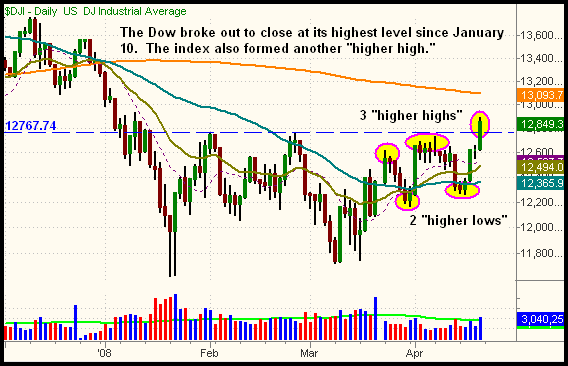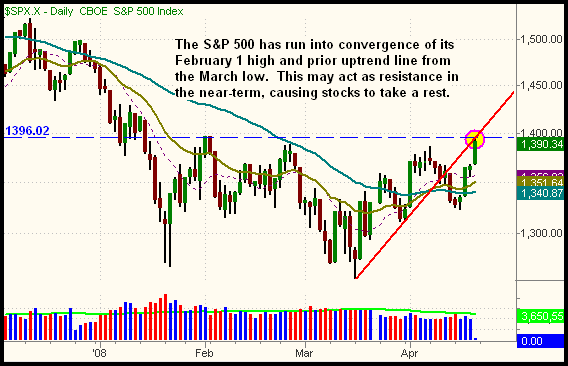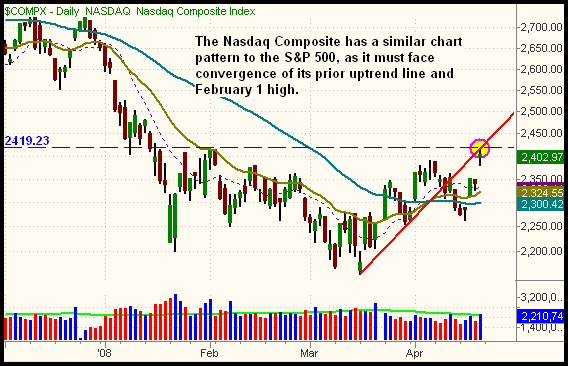| The Wagner Daily ETF Report for April 21 |
| By Deron Wagner |
Published
04/20/2008
|
Stocks
|
Unrated
|
|
|
|
The Wagner Daily ETF Report for April 21
Stocks capped the week on a rather bullish note last Friday, as the major indices zoomed past their prior "swing highs" from earlier this month. A very positive reaction to Google's latest quarterly earnings report caused the main stock market indexes to each open approximately 2% higher. Equities moved a little higher throughout the morning, but surrendered those additional gains later in the afternoon. Both the S&P 500 and Dow Jones Industrial Average settled 1.8% higher, while the Nasdaq Composite climbed 2.6%. The small-cap Russell 2000 gained 1.9%. The S&P Midcap 400 Index advanced 1.5%. The major indices finished off their best levels of the session, but in the upper third of their intraday ranges. Since stocks essentialy closed near their opening prices, profiting from the day's gains was a bit challenging for traders unless already positioned long to start the day.
Turnover surged higher across the board, allowing both the S&P 500 and Nasdaq Composite to score their third "accumulation day" of the week. Total volume in both the NYSE and Nasdaq raced 21% above the previous day's levels, a sign that institutions are becoming increasingly comfortable with participating on the buy side of the market. Although the monthly expiration of options contracts was likely a contributing factor, turnover in the Nasdaq finally exceeded its 50-day average level for the first time in a month. Trading in the NYSE, however, remained below average. Market internals were quite solid. Advancing volume in the NYSE exceeded declining volume by a margin of 4 to 1. The Nasdaq ratio was positive by just over 5 to 1.
Last Friday's session was technically significant, as each of the main stock market indexes formed its third "higher high" since the broad market bottomed in mid-March. With three successive "higher highs" and two successive "higher lows" on the daily charts of the major indices, their intermediate-term uptrends we've been discussing since the beginning of the month have been further confirmed. The Dow Jones Industrial Average also closed at its highest level since January 10 of this year. The series of "higher highs" and "higher lows," as well as the breakout above horizontal price resistance, is shown on the following daily chart of the blue-chip index:

Rewinding back to our commentary in the April 17 issue of The Wagner Daily, recall we discussed key technical levels of horizontal price resistance the major indices must overcome in the near-term (click here to review that day's issue). For the Dow, we said resistance was the area between 12,733 to 12,767. Closing at 12,849 last Friday, the Dow cruised through that area of resistance, which is why the index set its highest closing price in more than three months. But both the S&P 500 and Nasdaq Composite finished just below resistance of their February 1 highs. The blue dashed horizontal lines on the daily charts of the S&P and Nasdaq illustrate this:


It's obviously bullish that both the S&P and Nasdaq finished above their prior "swing highs" from earlier in the month, but both indexes may need a period of consolidation before breaking out above their levels of horizontal price resistance shown above. This is because the indexes have also run into resistance of their prior uptrend lines that began with the March 17 lows and anchored with the March 31 lows. Why is this resistance? Simply because a prior level of support always becomes the new resistance after the support is broken. Many novice technical traders incorrectly overlook the importance of noting prior trendlines, but this causes them to miss strong areas of support/resistance. Most importantly, notice that the prior uptrend lines on the S&P and Nasdaq (the ascending red lines) converge with the horizontal price resistance levels from the February 1 highs. Such convergence of resistance normally makes it more difficult for a stock, ETF, or index to move higher without at least digesting their gains for a few days or longer.
As last week's price action was quite bullish and confirmed the intermediate-term uptrends of the major indices, we're certainly not suggesting a bearish stance on the market in the near-term. Rather, we're simply making you aware of a significant technical reason that stocks may take a "pause for the cause" this week. Any narrow-range price consolidation on lighter volume would be bullish and increase the odds of further gains over the next several weeks, but it still may be a good idea to tighten protective stops on any long positions showing a nice profit. Further, we also must be cognizant of a more substantial resistance level the major indices are approaching -- the weekly downtrend lines from their October 2007 highs. We'll take an updated look at the longer-term weekly charts later this week.
Open ETF positions:
Long - INP
Short - (none)
Deron Wagner is the Founder and Head Trader of both Morpheus Capital LP, a U.S. hedge fund, and Morpheus Trading Group, a trader education firm launched in 2001 that provides daily technical analysis of the leading ETFs and stocks. For a free trial to the full version of The Wagner Daily or to learn about Wagner's other services, visit MorpheusTrading.com or send an e-mail to deron@morpheustrading.com.
|